Historical Variation of IEA Energy and CO2 Emission Projections: Implications for Future Energy Modeling
Abstract
:1. Introduction
2. Materials and Methods
2.1. Data and Regions Considered
2.2. Key Indicators and Methods
3. Results
3.1. Variation in Projections between 1994 and 2010
3.2. Variation in Projections from 1990 to 2040
3.2.1. TPED
3.2.2. CO2 Emissions from the Energy Sector
3.2.3. Generated RES Electricity
3.3. Implications for the NDCs
4. Discussion
5. Conclusions
Author Contributions
Funding
Institutional Review Board Statement
Informed Consent Statement
Data Availability Statement
Acknowledgments
Conflicts of Interest
Appendix A
| WEO Edition | Regional Definitions | ||||||
|---|---|---|---|---|---|---|---|
| OECD North America | OECD Europe/Europe (after 2017) | OECD Pacific | Africa | China | South Asia/ India | Russia | |
| 1994 | Canada and United States | Austria, Belgium, Denmark, Finland, France, Germany, Greece, Iceland *, Ireland, Italy, Luxembourg, Netherlands, Norway, Portugal, Spain, Sweden, Switzerland, Turkey and United Kingdom | Australia, Japan and New Zealand | All African countries | China | South Asia (including Pakistan, Bangladesh, Sri Lanka and Nepal) | Former Soviet Union (not considered in this analysis) |
| 1996 | |||||||
| 1998 | + Czech Republic and Hungary | ||||||
| 2000 | +Poland | India | Russia | ||||
| 2002 | +Mexico | + Korea | |||||
| 2004 | +Slovak Republic | ||||||
| 2006 | |||||||
| 2008 | |||||||
| 2010 | |||||||
| 2012 | + Estonia and Slovenia * | ||||||
| 2015 | +Israel * | ||||||
| 2017 | + Bulgaria *, Croatia *, Cyprus *, Latvia *, Lithuania *, Malta *, Romania *, Albania *, Belarus *, Bosnia and Herzegovina *, Gibraltar *, Kosovo *, Montenegro *, Serbia *, the Former Yugoslav Republic of Macedonia *, the Republic of Moldova * and Ukraine * | ||||||
| 2018 | |||||||
Appendix B
| Region | Population (Millions) | % Variation ‘90–’13 | CO2 Emissions from Energy (Mt CO2e) | % Variation ‘90–’13 | GDP PPP (USD Billion in 2010) | % Variation ‘90–’13 | |||
|---|---|---|---|---|---|---|---|---|---|
| 1990 | 2013 | 1990 | 2013 | 1990 | 2013 | ||||
| World | 5288 | 7185 | 36% | 20.518 | 32.288 | 57% | 46.097 | 98.997 | 115% |
| OECD | 1069 | 1265 | 18% | 11.020 | 12.031 | 9% | 29.088 | 45.719 | 57% |
| OECD Europe | 543 | 596 | 10% | 3924 | 3563 | −9% | 12.307 | 18.697 | 52% |
| OECD N. America | 363 | 474 | 31% | 5508 | 6187 | 12% | 11.047 | 19.524 | 77% |
| China | 1135 | 1357 | 20% | 2089 | 9191 | 340% | 1698 | 15.894 | 836% |
| India | 870 | 1279 | 47% | 530 | 1853 | 249% | 1496 | 6356 | 325% |
| Russia | 148 | 144 | −3% | 2163 | 1514 | −30% | 2715 | 3201 | 18% |
| Africa | 629 | 1122 | 78% | 529 | 1086 | 105% | 2106 | 5012 | 138% |
| Region | TPED per Capita (MWh/Capita) | % Variation ‘90–’13 | Electricity per Capita (MWh/Capita) | % Variation ‘90–’13 | CO2 Emissions from Energy per Capita (t CO2e/Capita) | % Variation ‘90–’13 | |||
| 1990 | 2013 | 1990 | 2013 | 1990 | 2013 | ||||
| World | 19.30 | 22.27 | 15% | 1.83 | 2.72 | 48% | 3.88 | 4.49 | 16% |
| OECD | 49.31 | 48.85 | −1% | 6.01 | 7.44 | 24% | 10.31 | 9.51 | −8% |
| OECD Europe | 34.85 | 33.97 | −3% | 4.12 | 5.14 | 25% | 7.22 | 5.98 | −17% |
| OECD N. America | 72.58 | 65.93 | −9% | 8.73 | 9.69 | 11% | 15.18 | 13.05 | −14% |
| China | 8.95 | 24.94 | 179% | 0.40 | 3.31 | 729% | 1.84 | 6.77 | 268% |
| India | 4.09 | 7.08 | 73% | 0.25 | 0.68 | 176% | 0.61 | 1.45 | 138% |
| Russia | 68.96 | 58.34 | −15% | 5.57 | 5.19 | −7% | 14.59 | 10.55 | −28% |
| Africa | 7.24 | 7.86 | 9% | 0.41 | 0.53 | 30% | 0.84 | 0.97 | 15% |
| Region | TPED Intensity (MWh/1000 USD 2010) | % Variation ‘90–’13 | Electricity Intensity (MWh/1000 USD 2010) | % Variation ‘90–’13 | Carbon Intensity (t CO2e/1000 USD 2010) | % Variation ‘90–’13 | |||
| 1990 | 2013 | 2013 | 1990 | 1990 | 2013 | ||||
| World | 2.21 | 1.62 | −27% | 0.21 | 0.20 | −6% | 0.45 | 0.33 | −27% |
| OECD | 1.81 | 1.35 | −25% | 0.22 | 0.21 | −7% | 0.38 | 0.26 | −31% |
| OECD Europe | 1.54 | 1.08 | −30% | 0.18 | 0.16 | −10% | 0.32 | 0.19 | −40% |
| OECD N. America | 2.38 | 1.60 | −33% | 0.29 | 0.24 | −18% | 0.50 | 0.32 | −36% |
| China | 5.98 | 2.13 | −64% | 0.27 | 0.28 | 6% | 1.23 | 0.58 | −53% |
| India | 2.38 | 1.42 | −40% | 0.14 | 0.14 | −4% | 0.35 | 0.29 | −18% |
| Russia | 3.77 | 2.62 | −31% | 0.30 | 0.23 | −24% | 0.80 | 0.47 | −41% |
| Africa | 2.16 | 1.76 | −19% | 0.12 | 0.12 | −3% | 0.25 | 0.22 | −14% |
References
- Jebaraj, S.; Iniyan, S. A review of energy models. Renew. Sustain. Energy Rev. 2006, 10, 281–311. [Google Scholar] [CrossRef]
- Chiodi, A.; Taylor, P.G.; Seixas, J.; Simões, S.; Fortes, P.; Gouveia, J.P.; Dias, L.; Gallachóir, B.Ó. Energy Policies Influenced by Energy Systems Modelling—Case Studies in UK, Ireland, Portugal and G8. In In-Forming Energy Climate Policies Using Energy Systems Modelling; Giannakidis, G., Labriet, M., Gallachóir, B.Ó., Tosato, G., Eds.; Springer: Cham, Switzerland, 2019; pp. 15–41. [Google Scholar]
- Cabeza, L.F.; Palacios, A.; Serrano, S.; Ürge-Vorsatz, D.; Barreneche, C. Comparison of past projections of global and regional primary and final energy consumption with historical data. Renew. Sustain. Energy Rev. 2018, 82, 681–688. [Google Scholar] [CrossRef] [Green Version]
- Smil, V. Perils of Long-Range Energy Forecasting: Reflections on Looking Far Ahead. Technol. Forecast. Soc. Chang. 2000, 65, 251–264. [Google Scholar] [CrossRef]
- Craig, P.P.; Gadgil, A.; Koomey, J.G. What Can History Teach Us? A Retrospective Examination of Long-Term Energy Forecasts for the United States. Annu. Rev. Energy Environ. 2002, 27, 83–118. [Google Scholar] [CrossRef] [Green Version]
- Morgan, M.G.; Keith, D.W. Improving the way we think about projecting future energy use and emissions of carbon dioxide. Clim. Chang. 2008, 90, 189–215. [Google Scholar] [CrossRef]
- Cornell, S.; Costanza, R.; Sörlin, S.; Van Der Leeuw, S. Developing a systematic “science of the past” to create our future. Glob. Environ. Chang. 2010, 20, 426–427. [Google Scholar] [CrossRef]
- DeCarolis, J.; Daly, H.; Dodds, P.; Keppo, I.; Li, F.; McDowall, W.; Pye, S.; Strachan, N.; Trutnevyte, E.; Usher, W.; et al. Formalizing best practice for energy system optimization modelling. Appl. Energy 2017, 194, 184–198. [Google Scholar] [CrossRef] [Green Version]
- Trutnevyte, E. The allure of energy visions: Are some visions better than others? Energy Strat. Rev. 2014, 2, 211–219. [Google Scholar] [CrossRef]
- Fortes, P.; Alvarenga, A.; Seixas, J.; Rodrigues, A.M.A. Long-term energy scenarios: Bridging the gap between socio-economic storylines and energy modeling. Technol. Forecast. Soc. Chang. 2015, 91, 161–178. [Google Scholar] [CrossRef]
- Carrington, G.; Stephenson, J. The politics of energy scenarios: Are International Energy Agency and other conservative projections hampering the renewable energy transition? Energy Res. Soc. Sci. 2018, 46, 103–113. [Google Scholar] [CrossRef]
- Muttitt, G.; Scott, A.; Buckley, T. Off Track: How the International Energy Agency Guides Energy Decisions towards Fossil Fuel Dependence and Climate Change. 2018. Available online: http://priceofoil.org/content/uploads/2018/04/OFF-TRACK-the-IEA-Climate-Change.pdf (accessed on 12 February 2020).
- Greenpeace, Energy Revolution: A Sustainable World Energy Outlook 2015. 100% Renewable Energy for All, Greenpeace International. 2015. Available online: http://www.greenpeace.org/international/Global/international/publications/climate/2015/Energy-Revolution-2015-Full.pdf (accessed on 12 February 2020).
- WWF. The Energy Report: 100% Renewable Energy by 2050, WWF—World Wide Fund for Nature, Gland. 2011. Available online: https://c402277.ssl.cf1.rackcdn.com/publications/384/files/original/The_Energy_Report.pdf?1345748859 (accessed on 12 February 2020).
- WEC. World Energy Scenarios: Composing Energy Futures to 2050, World Energy Council, London. 2013. Available online: https://www.worldenergy.org/assets/downloads/World-Energy-Scenarios_Composing-energy-futures-to-2050_Full-report1.pdf (accessed on 12 February 2020).
- Jacobson, M.Z.; Delucchi, M.A. Providing all global energy with wind, water, and solar power, Part I: Technologies, energy resources, quantities and areas of infrastructure, and materials. Energy Policy 2011, 39, 1154–1169. [Google Scholar] [CrossRef]
- van Vuuren, D.P.; Nakicenovic, N.; Riahi, K.; Brew-Hammond, A.; Kammen, D.; Modi, V.; Nilsson, M.; Smith, K.R. An energy vision: The transformation towards sustainability—Interconnected challenges and solutions. Curr. Opin. Environ. Sustain. 2012, 4, 18–34. [Google Scholar] [CrossRef]
- Bruckner, T.; Bashmakov, I.A.; Mulugetta, Y. AR5 Climate Change 2014: Mitigation of Climate Change; IPCC: Geneva, Switzerland, 2014; Chapter 7; Volume 5, pp. 511–598. Available online: https://www.ipcc.ch/site/assets/uploads/2018/02/ipcc_wg3_ar5_chapter7.pdf (accessed on 25 October 2020).
- International Energy Agency (IEA); International Renewable Energy Agency (IRENA); UN; World Bank Group. Tracking SDG7: The Energy Progress Report, Washington. 2018. Available online: https://openknowledge.worldbank.org/handle/10986/29812 (accessed on 12 February 2020).
- Seixas, J.; Simões, S.G.; Fortes, P.; Gouveia, J.P. The Pivotal Role of Electricity in the Deep Decarbonization of Energy Systems: Cost-Effective Options for Portugal. In Limiting Global Warming to Well Below 2 °C: Energy System Modelling and Policy Development. Lecture Notes in Energy; Giannakidis, G., Karlsson, K., Labriet, M., Gallachóir, B., Eds.; Springer: Cham, Switzerland, 2018; Volume 64, pp. 207–223. [Google Scholar]
- Fortes, P.; Simoes, S.; Gouveia, J.P.; Seixas, J. Electricity, the silver bullet for the deep decarbonisation of the energy system? Cost-effectiveness analysis for Portugal. Appl. Energy 2019, 237, 292–303. [Google Scholar] [CrossRef]
- Metayer, M.; Breyer, C.; Fell, H.-J. The projections for the future and quality in the past of the World Energy Outlook for solar PV and Other Renewable Energy Technologies. In Proceedings of the 31st European Photovoltaic Solar Energy Conference and Exhibition, Hamburg, Germany, 14–18 November 2015; Available online: https://www.eupvsec-proceedings.com/proceedings?paper=35067 (accessed on 12 February 2020).
- Carbon Tracker Initiative. Unburnable Carbon—Are the World’s Financial Markets Carrying a Carbon Bubble? 2011. Available online: https://www.carbontracker.org/reports/carbon-bubble/ (accessed on 12 February 2020).
- Carbon Tracker Initiative, Lost in Transition: How the Energy Sector Is Missing Potential Demand Destruction. 2015. Available online: http://www.carbontracker.org/report/lost_in_transition/ (accessed on 12 February 2020).
- UNFCCC. Adoption of the Paris Agreement: Proposal by the President to the United Nations Framework Convention on Climate Change. In Proceedings of the Conference of the Parties, Paris, France, 12 December 2015; pp. 1–32.
- Fawcett, A.; Iyer, G.C.; Clarke, L.E.; Edmonds, J.A.; Hultman, N.E.; McJeon, H.; Rogelj, J.; Schuler, R.; Alsalam, J.; Asrar, G.R.; et al. Can Paris pledges avert severe climate change? Science 2015, 350, 1168–1169. [Google Scholar] [CrossRef] [PubMed]
- Rogelj, J.; Elzen, M.D.; Höhne, N.; Fransen, T.; Fekete, H.; Winkler, H.; Schaeffer, R.; Sha, F.; Riahi, K.; Meinshausen, M. Paris Agreement climate proposals need a boost to keep warming well below 2 °C. Nat. Cell Biol. 2016, 534, 631–639. [Google Scholar] [CrossRef] [Green Version]
- Elzen, M.D.; Admiraal, A.; Roelfsema, M.; Van Soest, H.; Hof, A.; Forsell, N. Contribution of the G20 economies to the global impact of the Paris agreement climate proposals. Clim. Chang. 2016, 137, 655–665. [Google Scholar] [CrossRef] [Green Version]
- Rogelj, J.; Fricko, O.; Meinshausen, M.; Krey, V.; Zilliacus, J.J.J.; Riahi, K. Understanding the origin of Paris Agreement emission uncertainties. Nat. Commun. 2017, 8, 15748. [Google Scholar] [CrossRef] [PubMed] [Green Version]
- The Emissions Gap Report. United Nations Environment Programme, Nairobi. 2020. Available online: https://www.unep.org/emissions-gap-report-2020 (accessed on 13 February 2021).
- International Energy Agency (IEA). World Energy Outlook 1994; IEA: Paris, France, 1994. [Google Scholar]
- International Energy Agency (IEA). World Energy Outlook 1996; IEA: Paris, France, 1996. [Google Scholar]
- International Energy Agency (IEA). World Energy Outlook 1998; IEA: Paris, France, 1998. [Google Scholar]
- International Energy Agency (IEA). World Energy Outlook 2000; IEA: Paris, France, 2000. [Google Scholar]
- International Energy Agency (IEA). World Energy Outlook 2002; IEA: Paris, France, 2002. [Google Scholar]
- International Energy Agency (IEA). World Energy Outlook 2004; IEA: Paris, France, 2004. [Google Scholar]
- International Energy Agency (IEA). World Energy Outlook 2006; IEA: Paris, France, 2006. [Google Scholar]
- International Energy Agency (IEA). World Energy Outlook 2008; IEA: Paris, France, 2008. [Google Scholar]
- International Energy Agency (IEA). World Energy Outlook 2010; IEA: Paris, France, 2010. [Google Scholar]
- International Energy Agency (IEA). World Energy Outlook 2012; IEA: Paris, France, 2012. [Google Scholar]
- International Energy Agency (IEA). World Energy Outlook 2015; IEA: Paris, France, 2015. [Google Scholar]
- International Energy Agency (IEA). World Energy Outlook 2017; IEA: Paris, France, 2017. [Google Scholar]
- International Energy Agency (IEA). World Energy Outlook 2018; IEA: Paris, France, 2018. [Google Scholar]
- International Energy Agency (IEA). World Energy Model Documentation, 2018 version; IEA: Paris, France, 2018. [Google Scholar]
- Figueres, C.; Schellnhuber, H.J.; Whiteman, G.; Rockström, J.; Hobley, A.; Rahmstorf, S. Three years to safeguard our climate. Nat. Cell Biol. 2017, 546, 593–595. [Google Scholar] [CrossRef] [PubMed]
- Rockström, J.; Gaffney, O.; Rogelj, J.; Meinshausen, M.; Nakicenovic, N.; Schellnhuber, H.J. A roadmap for rapid decarbonization. Science 2017, 355, 1269–1271. [Google Scholar] [CrossRef] [PubMed] [Green Version]
- Keepin, B. A technical appraisal of the IIASA energy scenarios. Policy Sci. 1984, 17, 199–276. [Google Scholar] [CrossRef]
- Teotónio, C.; Fortes, P.; Roebeling, P.; Rodriguez, M.; Robaina-Alves, M. Assessing the impacts of climate change on hydropower generation and the power sector in Portugal: A partial equilibrium approach. Renew. Sustain. Energy Rev. 2017, 74, 788–799. [Google Scholar] [CrossRef]
- Creutzig, F.; Agoston, P.; Goldschmidt, J.C.; Luderer, G.; Nemet, G.; Pietzcker, R.C. The underestimated potential of solar energy to mitigate climate change. Nat. Energy 2017, 2, 17140. [Google Scholar] [CrossRef]
- Benveniste, H.; Boucher, O.; Guivarch, C.; Le Treut, H.; Criqui, P. Impacts of nationally determined contributions on 2030 global greenhouse gas emissions: Uncertainty analysis and distribution of emissions. Environ. Res. Lett. 2017, 13, 014022. [Google Scholar] [CrossRef]
- Fricko, O.; Havlik, P.; Rogelj, J.; Klimont, Z.; Gusti, M.; Johnson, N.; Kolp, P.; Strubegger, M.; Valin, H.; Amann, M.; et al. The marker quantification of the Shared Socioeconomic Pathway 2: A middle-of-the-road scenario for the 21st century. Glob. Environ. Chang. 2017, 42, 251–267. [Google Scholar] [CrossRef] [Green Version]
- Wilson, C.; Grubler, A.; Bauer, N.; Krey, V.; Riahi, K. Future capacity growth of energy technologies: Are scenarios consistent with historical evidence? Clim. Chang. 2013, 118, 381–395. [Google Scholar] [CrossRef] [Green Version]
- Weijermars, R.; Taylor, P.; Bahn, O.; Das, S.R.; Wei, Y.-M. Review of models and actors in energy mix optimization—Can leader visions and decisions align with optimum model strategies for our future energy systems? Energy Strat. Rev. 2012, 1, 5–18. [Google Scholar] [CrossRef] [Green Version]
- Ghorbani, A.; Dechesne, F.; Dignum, V.; Jonker, C. Enhancing ABM into an Inevitable Tool for Policy Analysis. J. Policy Complex Syst. 2014, 1, 61–76. [Google Scholar] [CrossRef]
- Holtz, G.; Alkemade, F.; de Haan, F.; Köhler, J.; Trutnevyte, E.; Luthe, T.; Halbe, J.; Papachristos, G.; Chappin, E.; Kwakkel, J.; et al. Prospects of modelling societal transitions: Position paper of an emerging community. Environ. Innov. Soc. Transit. 2015, 17, 41–58. [Google Scholar] [CrossRef]
- Sun, Z.; Lorscheid, I.; Millington, J.D.; Lauf, S.; Magliocca, N.R.; Groeneveld, J.; Balbi, S.; Nolzen, H.; Müller, B.; Schulze, J.; et al. Simple or complicated agent-based models? A complicated issue. Environ. Model. Softw. 2016, 86, 56–67. [Google Scholar] [CrossRef] [Green Version]
- Tong, D.; Zhang, Q.; Zheng, Y.; Caldeira, K.; Shearer, C.; Hong, C.; Qin, Y.; Davis, S.J. Committed emissions from existing energy infrastructure jeopardize 1.5 °C climate target. Nat. Cell Biol. 2019, 572, 373–377. [Google Scholar] [CrossRef]
- Strachan, N. Business-as-Unusual: Existing policies in energy model baselines. Energy Econ. 2011, 33, 153–160. [Google Scholar] [CrossRef]
- Fragkos, P.; Tasios, N.; Paroussos, L.; Capros, P.; Tsani, S. Energy system impacts and policy implications of the European Intended Nationally Determined Contribution and low-carbon pathway to 2050. Energy Policy 2017, 100, 216–226. [Google Scholar] [CrossRef]
- Gu, J.; Renwick, N.; Xue, L. The BRICS and Africa’s search for green growth, clean energy and sustainable development. Energy Policy 2018, 120, 675–683. [Google Scholar] [CrossRef]

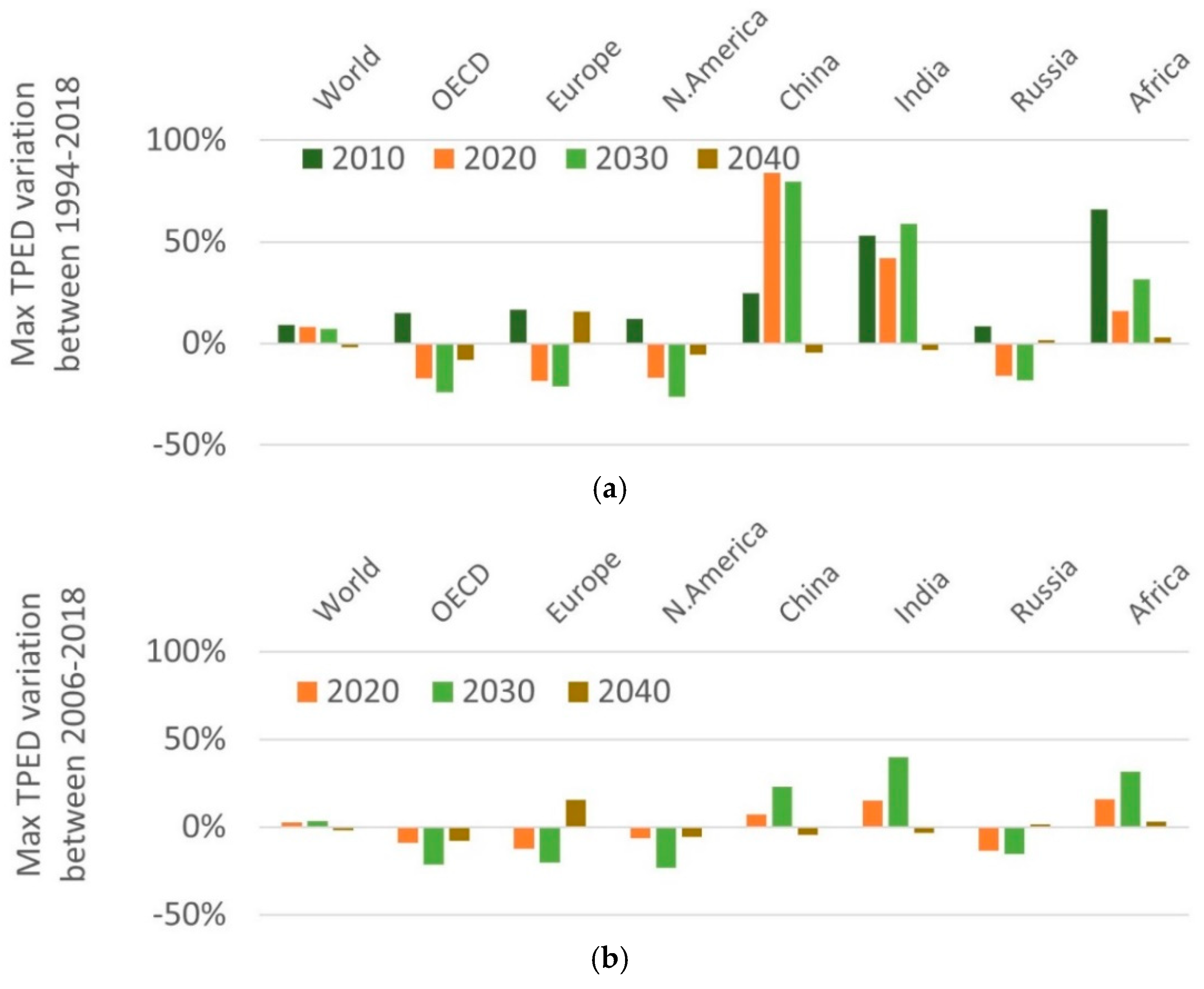
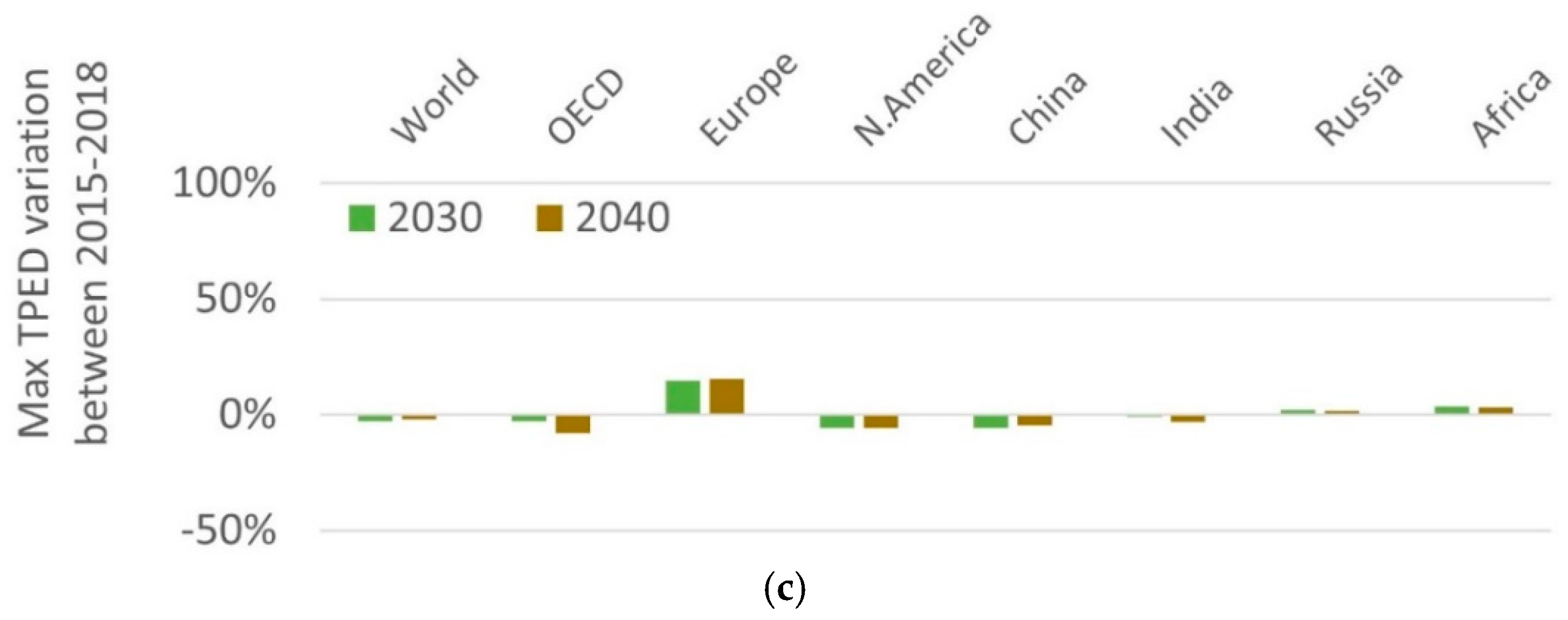

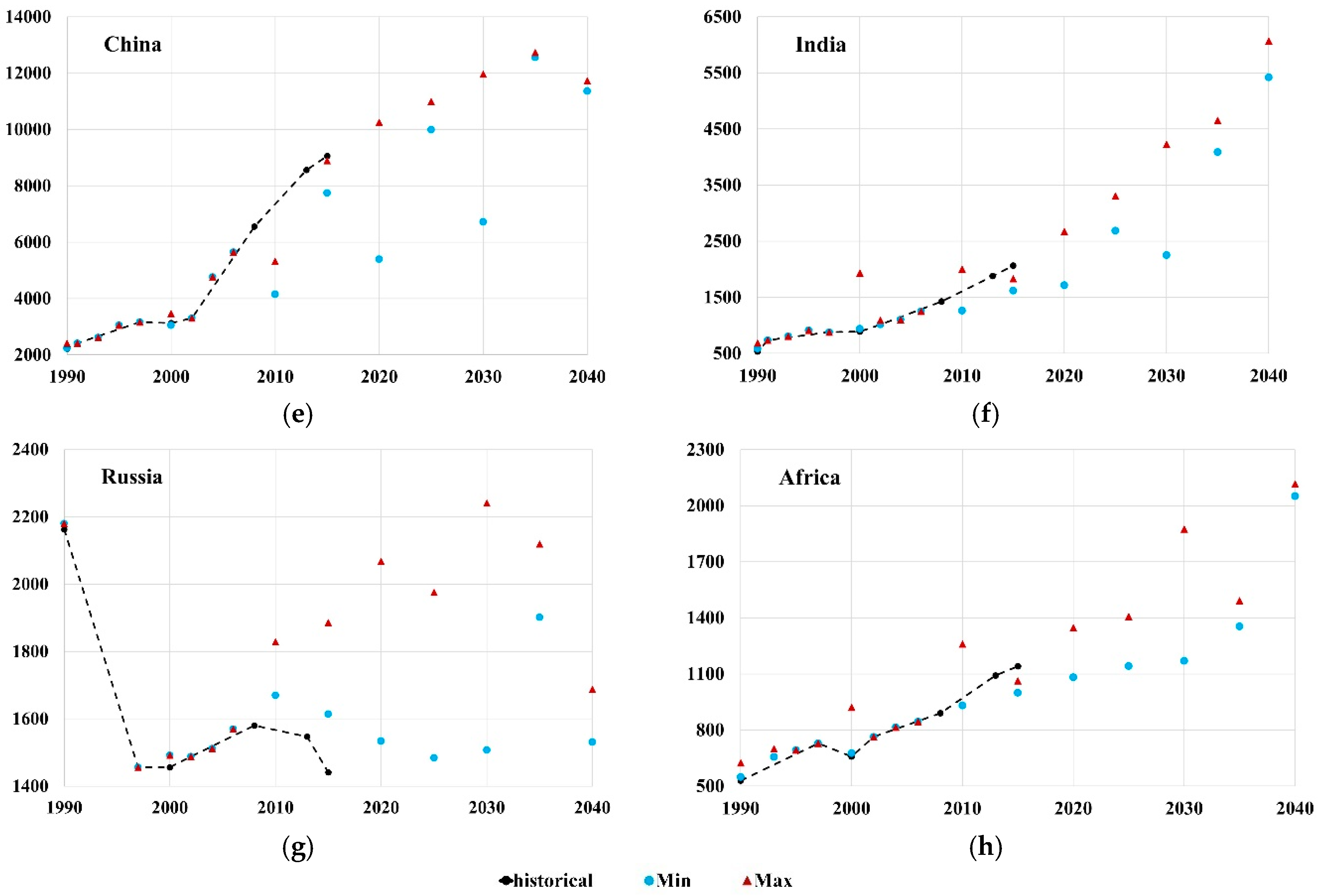
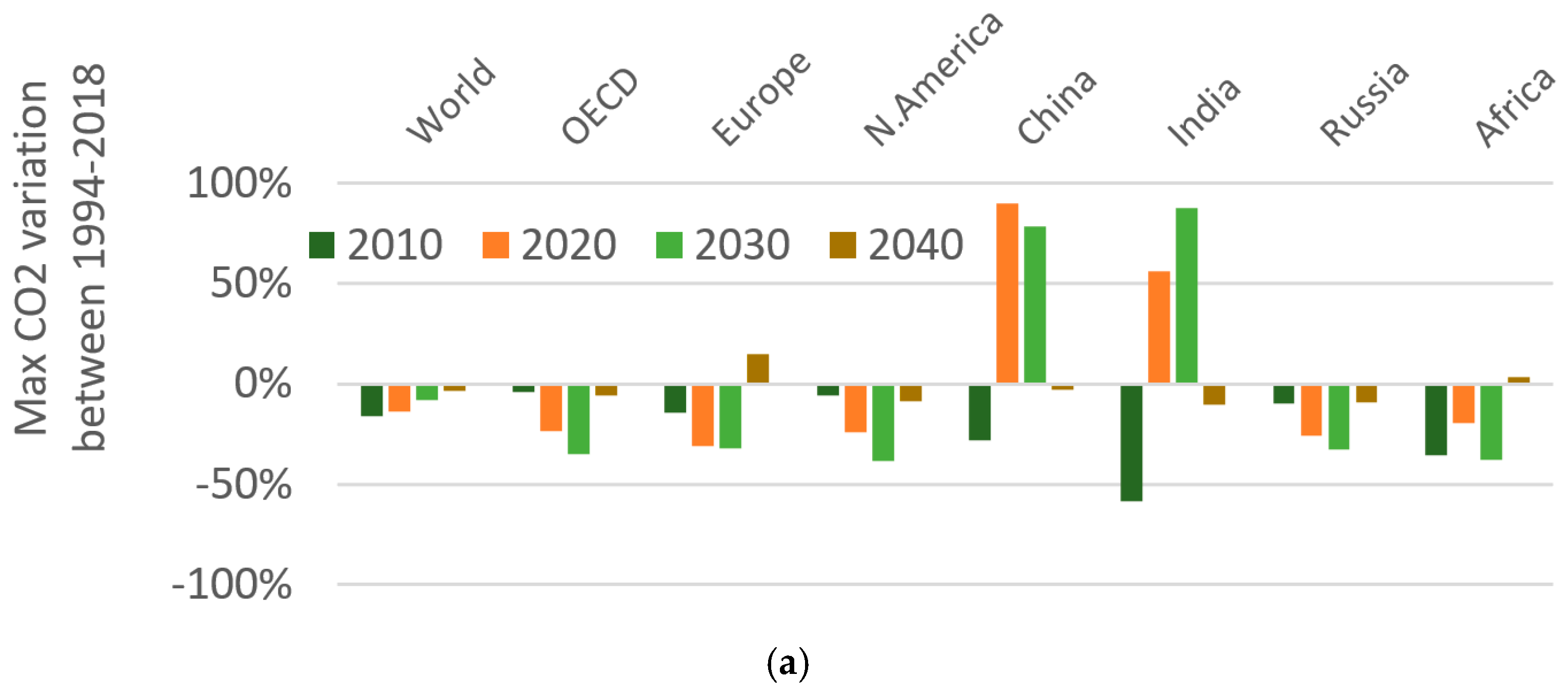
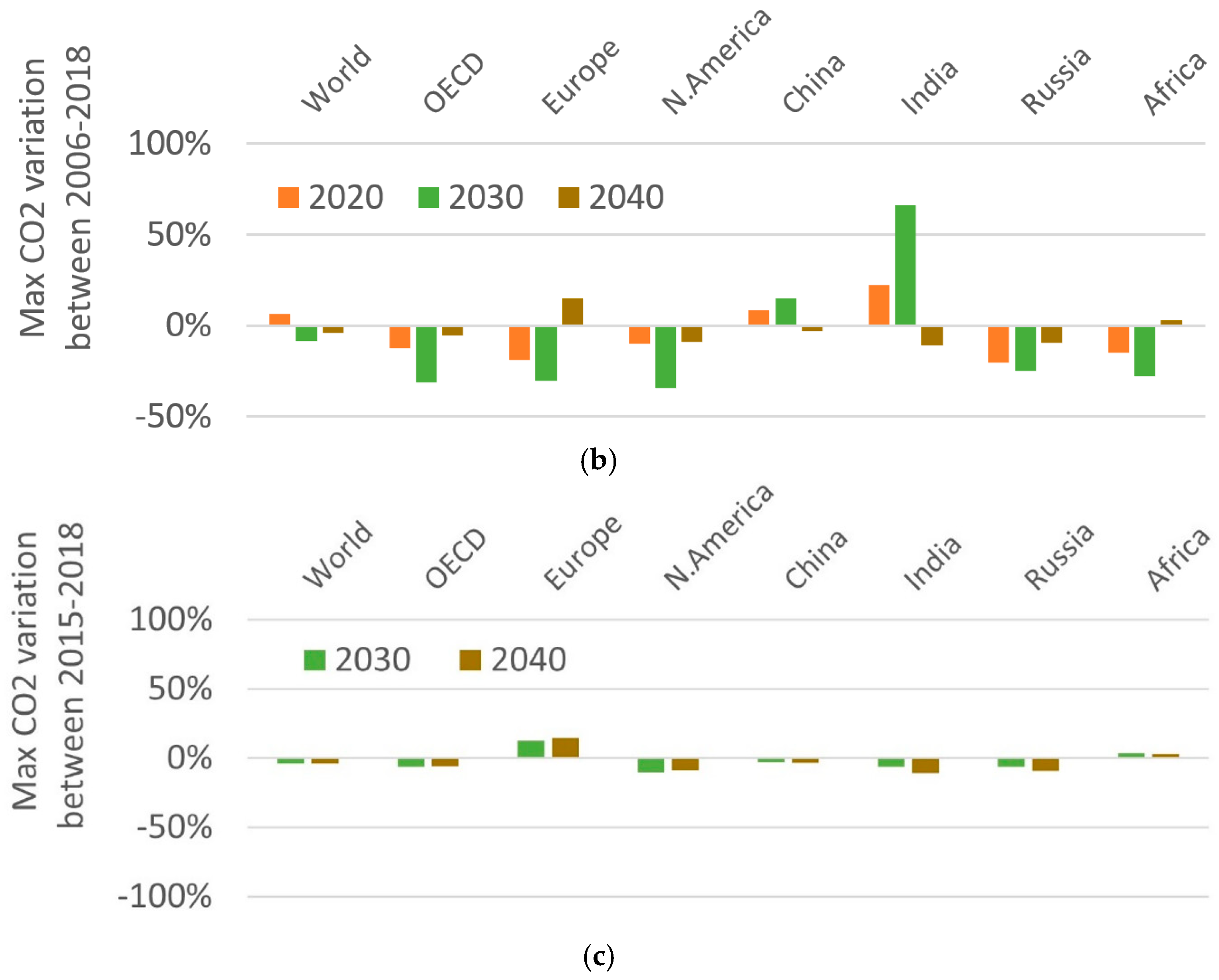

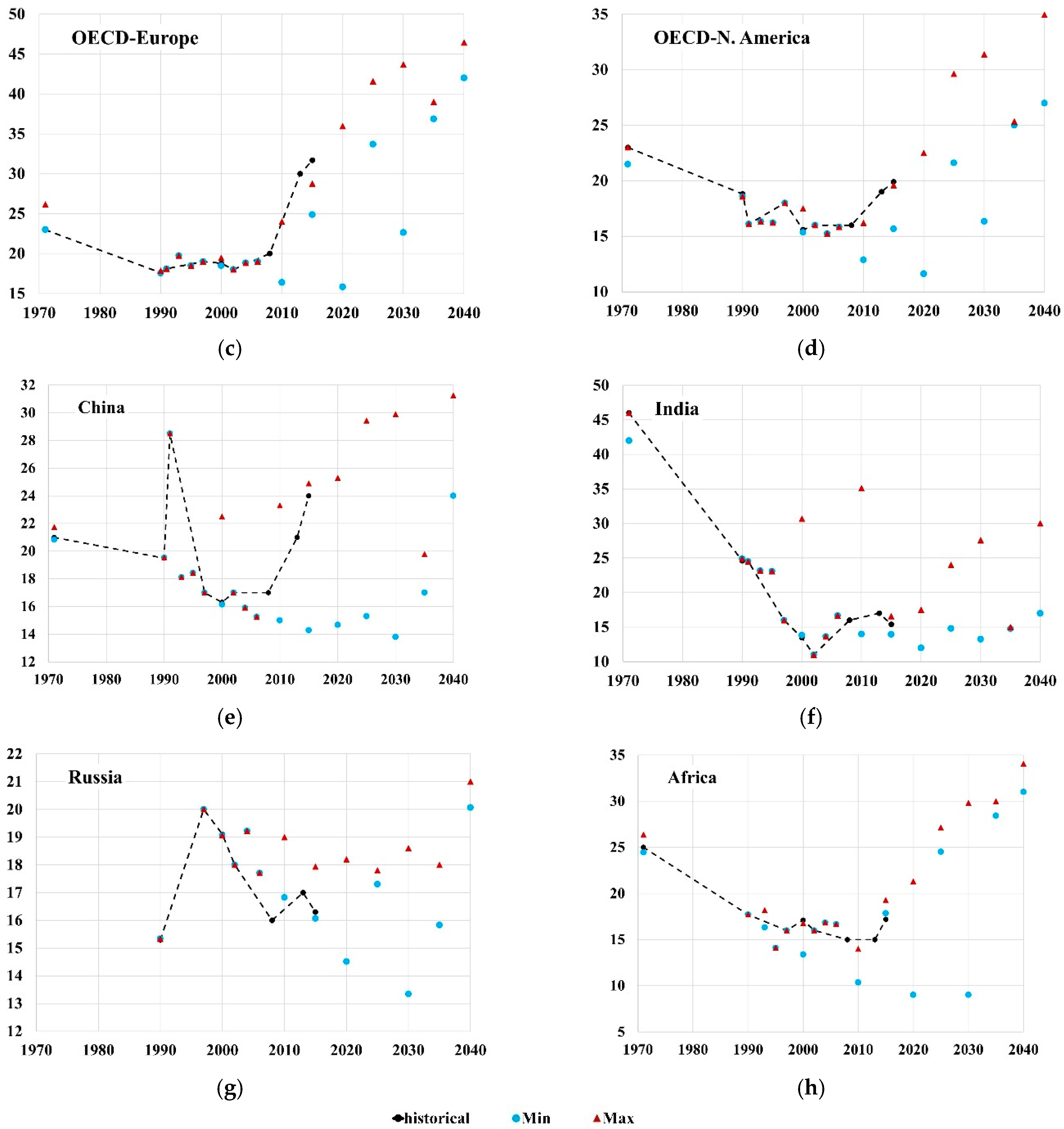
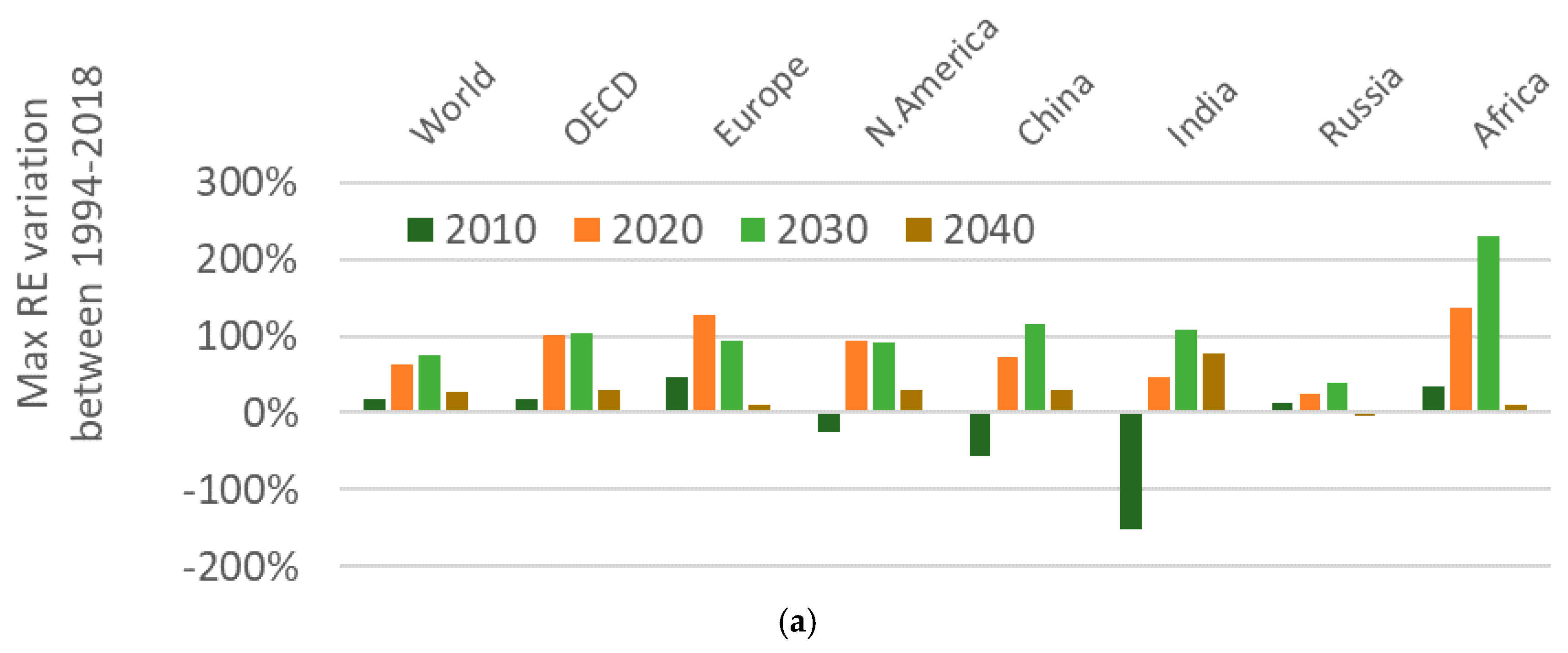
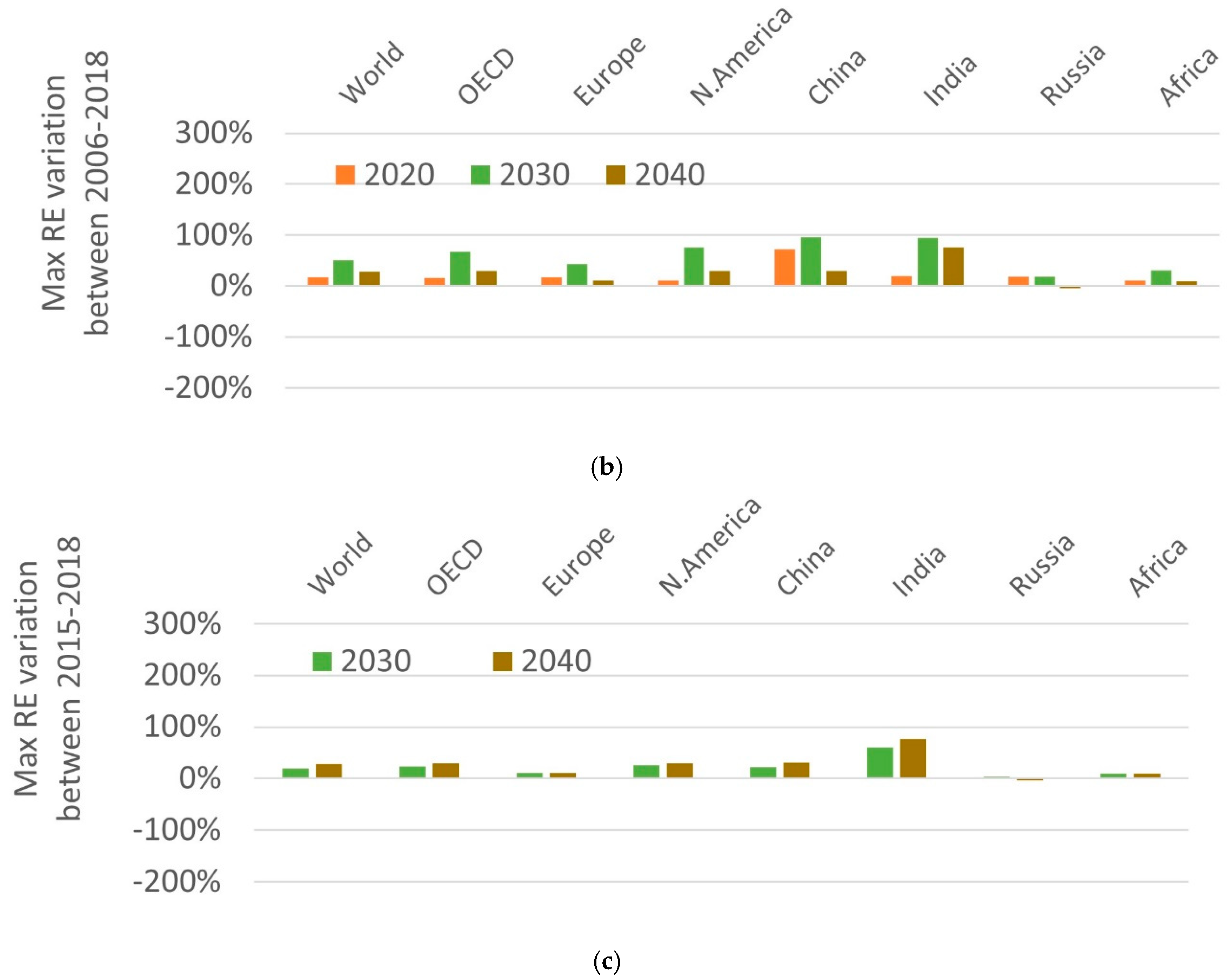
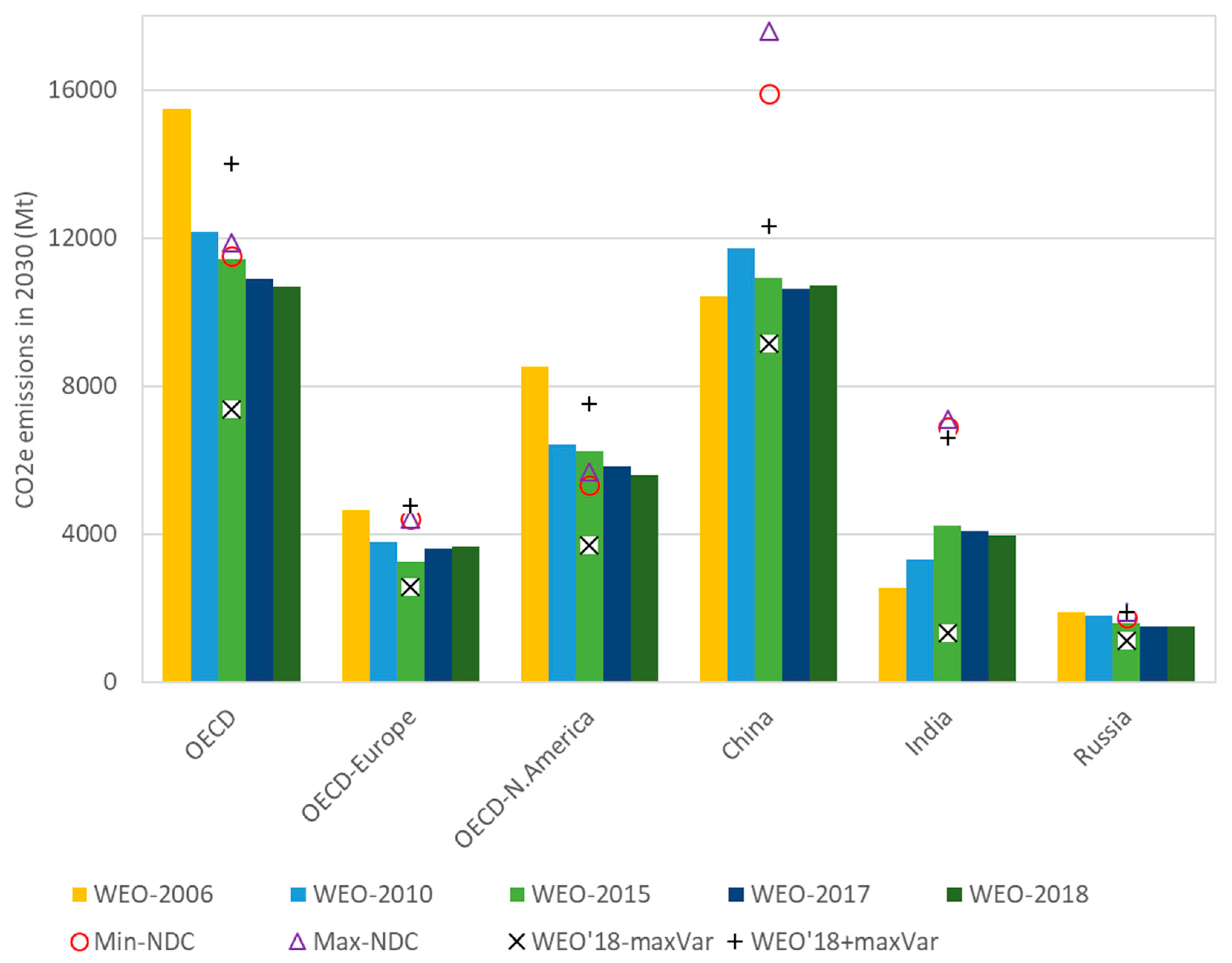
| Publication Year | Years for Which Data or Projections Are Given | IEA Scenario |
|---|---|---|
| 1994 [31] | 1971 *, 1991 *, 2000, 2010 | “Reference” Scenario |
| 1996 [32] | 1971 *, 1993 *, 2000, 2010 | |
| 1998 [33] | 1971 *, 1990 *, 1995 *, 2010, 2020 | |
| 2000 [34] | 1971 *, 1997 *, 2010, 2020 | |
| 2002 [35] | 1971 *, 2000 *, 2010, 2020, 2030 | |
| 2004 [36] | 1971 *, 2002 *, 2010, 2020, 2030 | |
| 2006 [37] | 1990 *, 2004 *, 2015, 2030 | |
| 2008 [38] | 1990 *, 2006 *, 2015, 2020, 2025, 2030 | |
| 2010 [39] | 2020, 2030, 2035 | “Current Policies” Scenario |
| 2012 [40] | 2020, 2030, 2035 | |
| 2015 [41] | 2020, 2030, 2040 | |
| 2017 [42] | 2025, 2030, 2040 | |
| 2018 [43] | 2025 2030, 2040 |
| Region | Historical Variation ‘94–’10 | Average of WEO Projections for 2010 | ||
|---|---|---|---|---|
| Population | GDP PPP (USD Billion in 2010) | Population | GDP PPP (USD Billion in 2010) | |
| World | 23% | 79% | 23% | 65% |
| OECD | 12% | 43% | 8% | 44% |
| OECD Europe | 7% | 40% | 3% | 42% |
| OECD N. America | 20% | 49% | 14% | 46% |
| China | 12% | 358% | 15% | 169% |
| India | 31% | 198% | 28% | 118% |
| Russia | −4% | 66% | −7% | 73% |
| Africa | 49% | 106% | 46% | 74% |
| Region | Historical Variation ‘94–’10 | Average of WEO Projections for 2010 | ||||
|---|---|---|---|---|---|---|
| TPED | CO2 Emissions (from Energy) | Total ELC | TPED | CO2 Emissions (from Energy) | Total ELC | |
| World | 43% | 47% | 68% | 35% | 44% | 73% |
| OECD | 14% | 9% | 32% | 17% | 19% | 41% |
| OECD Europe | 12% | 0% | 31% | 17% | 16% | 42% |
| OECD N. America | 11% | 10% | 27% | 19% | 23% | 41% |
| China | 161% | 200% | 354% | 62% | 84% | 172% |
| India | 99% | 142% | 145% | 91% | 145% | 209% |
| Russia | 5% | −4% | 19% | 7% | 8% | 35% |
| Africa | 64% | 80% | 87% | 35% | 96% | 114% |
| Region | Historical Variation ‘94–’10 (per Capita) | Average of WEO Projections for 2010 (per Capita) | ||||
|---|---|---|---|---|---|---|
| TPED | CO2 Emissions (from Energy) | Total ELC | TPED | CO2 Emissions (from Energy) | Total ELC | |
| Avg | Avg | Avg | ||||
| World | 16% | 19% | 36% | 10% | 17% | 41% |
| OECD | 1% | −3% | 17% | 10% | 11% | 31% |
| OECD Europe | 5% | −6% | 23% | 14% | 12% | 38% |
| OECD N. America | −7% | −8% | 6% | 4% | 8% | 23% |
| China | 132% | 167% | 305% | 41% | 60% | 138% |
| India | 53% | 85% | 87% | 50% | 90% | 140% |
| Russia | 9% | −1% | 24% | 16% | 17% | 45% |
| Africa | 10% | 21% | 25% | −7% | 34% | 47% |
| Region | Historical Variation ‘94–’10 (per USD 1000 in 2010) | Average of WEO Projections for 2010 (per USD 1000 in 2010) | ||||
|---|---|---|---|---|---|---|
| TPED | CO2 Emissions (from Energy) | Total ELC | TPED/1000 USD 2010 | CO2 Emissions (from Energy)/ USD 1000 in 2010 | Total ELC/ USD 1000 in 2010 | |
| World | −20% | −18% | −6% | −18% | −12% | −10% |
| OECD | −21% | −24% | −8% | −18% | −17% | −16% |
| OECD Europe | −20% | −28% | −7% | −17% | −18% | −14% |
| OECD N. America | −26% | −26% | −15% | −19% | −16% | −17% |
| China | −43% | −35% | −1% | −37% | −30% | −9% |
| India | −33% | −19% | −18% | −11% | 13% | 22% |
| Russia | −37% | −42% | −29% | −37% | −36% | −32% |
| Africa | −20% | −13% | −10% | −21% | 13% | 6% |
| Region or Country | Summary of NDCs | Methodology | Mt CO2e in 2030 |
|---|---|---|---|
| EU-28 | 40% GHG reduction in 2030, compared to 1990 | 1990 emissions, UNFCCC database | 3432 |
| Iceland | 40% GHG reduction in 2030, compared to 1990 | 1990 emissions, UNFCCC database | 2.101 |
| Norway | 40% GHG reduction in 2030, compared to 1990 | 1990 emissions, UNFCCC database | 31.05 |
| Switzerland | 50% GHG reduction in 2030, compared to 1990 | 1990 emissions, UNFCCC database | 22.3 |
| Turkey * | Reduction of up to 21% of GHG emissions from BAU by 2030 | BAU estimation in INDCs (not ratified yet) | 928 |
| USA | Reduce GHG emissions by 26–28% below its 2005 level in 2025 | assuming linear rate [50] | 4200–4400 |
| Canada | Reduce GHG emissions by 30% below 2005 levels by 2030 | 2005 emissions, UNFCCC database | 512 |
| Mexico | Reduce GHG emissions by 22–36% below BAU of 973 Mt. | BAU is given in NDCs | 623–759 |
| Australia | Economy-wide target to reduce GHG emissions by 26–28% below 2005 levels by 2030 | 2005 emissions, UNFCCC database | 402–414 |
| Japan | reduction of 26% by fiscal year (FY) 2030 compared to FY 2013 | 2013 emissions from NDCs | 771 |
| New Zealand | reduce GHG emissions to 30% below 2005 levels by 2030 | 2005 emissions, UNFCCC database | 57.8 |
| Republic of Korea | Emission reduction by 37% from BAU level by 2030 | BAU estimation given in NDCs | 536 |
| China | Peak emissions before 2030 + Lower CO2 emissions per unit of GDP by 60–65% from 2005 level | assuming SSP2 [50] | 15900–17600 |
| India | Reduction in emissions intensity of GDP by 33–35% from 2005 levels by 2030 | assuming SSP2 [50] | 6900–7100 |
| Russia | Limiting anthropogenic GHG to 70–75% of 1990 levels by 2030 | 1990 emissions, UNFCCC database (still INDCs) | 1757–1887 |
| Region | TPED | CO2 Emissions from the Energy Sector | Percentage of RES Electricity |
|---|---|---|---|
| World |
|
|
|
| OECD |
|
|
|
| OECD Europe |
|
|
|
| OECD N. America |
|
|
|
| China |
|
|
|
| India |
|
|
|
| Russia |
|
|
|
| Africa |
|
|
|
Publisher’s Note: MDPI stays neutral with regard to jurisdictional claims in published maps and institutional affiliations. |
© 2021 by the authors. Licensee MDPI, Basel, Switzerland. This article is an open access article distributed under the terms and conditions of the Creative Commons Attribution (CC BY) license (https://creativecommons.org/licenses/by/4.0/).
Share and Cite
Fazendeiro, L.M.; Simões, S.G. Historical Variation of IEA Energy and CO2 Emission Projections: Implications for Future Energy Modeling. Sustainability 2021, 13, 7432. https://doi.org/10.3390/su13137432
Fazendeiro LM, Simões SG. Historical Variation of IEA Energy and CO2 Emission Projections: Implications for Future Energy Modeling. Sustainability. 2021; 13(13):7432. https://doi.org/10.3390/su13137432
Chicago/Turabian StyleFazendeiro, Luís M., and Sofia G. Simões. 2021. "Historical Variation of IEA Energy and CO2 Emission Projections: Implications for Future Energy Modeling" Sustainability 13, no. 13: 7432. https://doi.org/10.3390/su13137432






